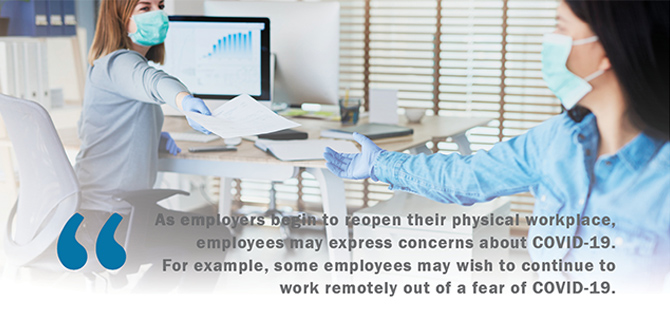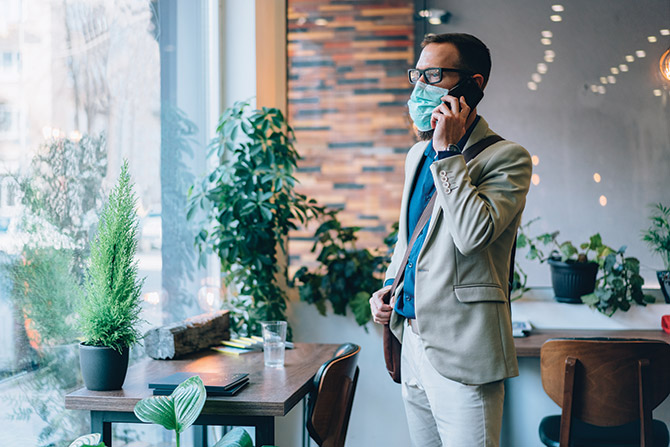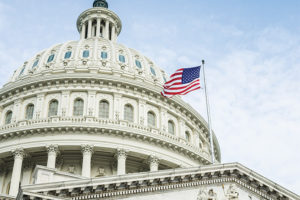By Jacqueline N. Tondl and John C. Dunn, Koley Jessen
As businesses begin to consider reopening their operations and returning employees to their locations and places of business, there are many things employers must consider and pitfalls employers will have to take care to avoid. Provided below are some important questions and answers to assist employers in reopening their operations and returning employees.
Is my business subject to a “stay-at-home” or “shelter-in-place” order?
Many states and localities remain under a “stay-at-home” or “shelter-in-place” order, which could prevent employers from reopening their physical workplaces. For more information from Koley Jessen regarding stay-at-home and shelter-in-place orders by state, see “Stay-at-Home, Shelter-in-Place, and Essential Business Information by State” on our website.
Should we develop enhanced cleaning procedures?
The short answer to this question is yes, but what the procedure looks like will differ based on the unique nature of each workplace and environment. Regardless of the nature of the workplace, employers are advised to clean and disinfect frequently used spaces such as bathrooms, breakrooms, common areas, and shared electronic equipment. The Center for Disease Control (CDC) advises the following cleaning procedures:
- Clean dirty surfaces with soap and water before disinfecting;
- Disinfect surfaces using products that meet the Environmental Protection Agency’s (EPA’s) criteria for COVID-19 (See https://www.epa.gov/pesticide-registration/list-n-disinfectants-use-against-sars-cov-2.);
- Cleaning staff should be equipped with and use disposable gloves and gowns; and
- Due to the risks and hazards associated with many cleaning products, additional personal protective equipment (PPE) may be necessary to protect employees engaging in cleaning activities.
Employers should also develop procedures for properly disposing of used cleaning products and PPE worn by individuals who are cleaning.
How can we implement social distancing at our workplace?
The CDC has issued guidance regarding policies to facilitate social distancing within the workplace, such as using videoconferencing or teleconferencing when possible for work-related meetings and gatherings, even if employees are in the same building. (See https://www.cdc.gov/coronavirus/2019-ncov/community/guidance-business-response.html.) If possible, employers should reconfigure workspaces to allow for the greatest level of social distancing and to otherwise protect against spread of the virus. One step that employers are taking is reconfiguring open workspaces to reduce the extent to which employees’ desks are directly facing each other.
Employers are also encouraged to place a limit on the number of employees who may be in a common area at one time. For example, employers may consider limiting the number of employees who may be in the break room at any given time to ensure enough space to allow for the recommended six feet of physical distance.
One of the most effective means of promoting social distancing in the office is to permit or require employees to continue to work remotely. See below for further discussion regarding telecommuting/working remote. The appropriate social distancing policy and practice will vary from workplace to workplace.
What other steps are employers taking to “reconfigure” their workplaces?
Employers may take many different steps to reconfigure workplaces to reduce the risk of COVID-19. The appropriate level of reconfiguration an employer will implement will vary largely depending on the employer’s space and resources. The following are examples of things employers can do to reconfigure a workplace:
- Utilizing “stable” work groups, where the employer designates a group of workers to work exclusively with one another and to avoid face-to-face interactions with employees outside of the group to limit the opportunity for widespread transmission of COVID-19.
- Engaging heating, ventilation, and air conditioning (HVAC) contractors to increase the level of air changes and ventilation in the workplace and/or install air filtration systems throughout the workplace.
- Installing “cough shields” and other partitions in common work areas.
Do we need a telecommuting policy even though our employees have been working from home for over a month?
In the rush to continue operations in the face of stay-at-home or shelter-in-place orders and other guidelines, many employers have had large portions of their workforces working from home without a formal policy. These employers would still benefit greatly from implementing a formal policy to govern both employees who are currently working from home as well as employees who work from home in the future. Even employers who had an existing telecommuting policy should revisit their existing policy to determine whether it needs to be revised or modified to address issues specific to the current environment and to account for issues that may have come to the employer’s attention with the increased number of employees working remotely. For example, an employee who gets injured at home while telecommuting may still have a compensable workers’ compensation claim. Employers should ensure such a situation is contemplated in a telecommuting policy. Employers could also take this opportunity to implement best practices that have developed during this period of mass telecommuting.
For a more in-depth discussion by Koley Jessen about remote work arrangements and telecommuting policies, see “Considerations for a Telecommuting Workforce During the COVID-19 Outbreak” on our website.
How should we prepare our employees to return to the workplace?
Employers must clearly communicate to employees the plans and processes that will govern the employees’ return to work. At a minimum, employees should be given information regarding the social distancing measures and prescreening protocols the employer will be utilizing. Informing employees what they can expect and keeping an open line of communication will help reduce employees’ fears and streamline the adoption and implementation of the new practices and processes.
When we bring employees back who have been laid off, do they need to fill out new hire paperwork?
This depends on whether the employer “terminated” the employees when they were laid off or if the employees were simply “furloughed” and placed on unpaid leave. If an employee was terminated, he or she should be extended a job offer and, if accepted, asked to complete a new set of onboarding paperwork, including completing a new Form I-9, even if the employer wishes to forgo interviews and new hire orientation. Note: Under certain circumstances, an employee who is rehired within three years may rely on the previous Form I-9 by following the steps provided at https://www.uscis.gov/i-9-central/52-reverifying-or-updating-employment-authorization-rehired-employees.
If the employee was furloughed, the employee does not need to complete new onboarding paperwork. However, it is important to consider whether the employee will need to complete new benefits elections if he or she was unable to maintain eligibility for benefits during the furlough. Additionally, employers should consider how other employer-provided benefits (e.g., paid time off) may be impacted by the furlough.
What if an employee says he or she will not come to work due to fears of COVID-19?
As employers begin to reopen their physical workplace, employees may express concerns about COVID-19. For example, some employees may wish to continue to work remotely out of a fear of COVID-19. Other employees may be concerned about transmitting the virus to a family member who is at high risk.
In such a case, employers should listen carefully to the employee’s concerns and reiterate all the steps they are taking to combat the spread of COVID-19 in the workplace. While employers should respect the employee’s position, employers are encouraged to set a specific date by which the employee must decide whether he or she wishes to return. In the event the employee fails to return to work by this date, employers may consider this a voluntary resignation of employment.

What if an employee says he or she is not ready to come back to work because the employee is comfortable remaining off work and receiving unemployment compensation?
If an employee indicates a desire to remain off work in order to continue receiving unemployment benefits because it is financially more lucrative for the employee than returning to work and there is no other COVID-19-related reason to justify the employee’s continued absence, the employee should be provided a definitive return-to-work date and advised that the employer has an obligation to notify the local department of labor as to the reinstatement offer so a determination as to continued eligibility for unemployment compensation benefits can be made based on complete information.
Should we take our employees’ temperatures? If so, under what circumstances?
The CDC has advised that critical infrastructure workers who have been exposed to COVID-19 should have their temperatures checked daily before beginning work for a period of at least 14 days since their last exposure, among other precautionary steps. What constitutes a critical infrastructure worker varies by state; however, the Department of Homeland Security has issued the guidance to assist employers in identifying critical infrastructure workforces. (See https://www.cisa.gov/identifying-critical-infrastructure-during-covid-19.) Koley Jessen has also produced a resource to help employers identify critical infrastructure workforces and essential businesses. (See “Considerations for a Telecommuting Workforce During the COVID-19 Outbreak” on our website.)
While the CDC’s guidance was issued for critical infrastructure workers (e.g., law enforcement and first responders), the same approach could be applied to employees in other industries in certain circumstances. Employers should determine whether an employee’s physical presence is necessary for this 14-day period after the employee has been exposed to COVID-19. However, employers should not rely on temperature checks as the sole means of preventing COVID-19 infections, as not every individual positive for COVID-19 has a temperature. (See https://www.cdc.gov/coronavirus/2019-ncov/community/critical-workers/implementing-safety-practices.html)
If employers decide to take employees’ temperatures, employers must determine who will be responsible for administering the temperature checks, including ensuring that this person has sufficient training and the proper equipment, including PPE, to accurately and effectively conduct the check.
Under the Americans with Disabilities Act (ADA), taking an employee’s temperature is considered a medical inquiry that can only be done if it is job-related and consistent with business necessity. In response to the COVID-19 pandemic, the Equal Employment Opportunity Commission (EEOC) issued guidance stating that temperature checks do not violate the ADA under the current circumstances. However, it is critical for employers to understand that the EEOC’s guidance is not indefinite and employers should continually confirm that the guidance remains in effect and its actions remain consistent with the guidance as this pandemic unfolds. The EEOC’s guidance regarding temperature checks under the ADA can be found at https://www.eeoc.gov/facts/pandemic_flu.html.
Can we require employees to be tested for COVID-19?
On April 23, 2020, the EEOC issued guidance stating that employers may require employees to undergo testing for COVID-19 as a condition of returning to work. The ADA requires that any mandatory medical test of employees be “job related and consistent with business necessity.” Applying this standard to the current circumstances of the COVID-19 pandemic, employers may take steps to determine if employees entering the workplace have COVID-19 because an individual with the virus will pose a direct threat to the health of others. Therefore, an employer may require employees undergo COVID-19 testing before they enter the workplace to determine if they have the virus. Consistent with the ADA standard articulated above, employers should ensure that the tests are accurate and reliable. For example, employers may review guidance from the U.S. Food and Drug Administration (FDA) about what may or may not be considered safe and accurate testing, as well as guidance from CDC or other public health authorities. (See the FDA’s FAQs at https://www.fda.gov/medical-devices/emergency-situations-medical-devices/faqs-testing-sars-cov-2.)
An employer’s ability to require employees to be tested for the COVID-19 virus or the antibodies to COVID-19 will also depend on whether sufficient testing capacity exists in the employer’s community. To the extent tests are available, employers must consider issues related to administering the tests, paying for the tests, and checking test results. (See https://www.cdc.gov/coronavirus/2019-ncov/symptoms-testing/testing.html.)
If we are hiring, can we screen applicants for symptoms of COVID-19?
Yes. An employer may screen job applicants for symptoms of COVID-19 after making a conditional job offer, as long as such screens are applied to all applicants for the same type of job. This ADA rule allowing post-offer (but not pre-offer) medical inquiries and exams applies to all applicants, whether or not the applicant has, or appears to have, COVID-19 or any other disability.
Can we delay the start date of an applicant who has COVID-19 or symptoms associated with it?
Yes. According to current CDC guidance, an individual
who has COVID-19 or symptoms associated with it should not
be in the workplace. The CDC has issued guidance applicable to all workplaces generally, but also has issued more specific guidance for particular types of workplaces (e.g., critical infrastructure workers).
Guidance from public health authorities is likely to change as the COVID-19 pandemic evolves; therefore, employers should continue to follow the most current information on maintaining workplace safety. (See https://www.osha.gov/SLTC/covid-19/additional_resources.html and https://www.cdc.gov/coronavirus/2019-ncov/community/general-business-faq.html.)
Can we withdraw a job offer if we need the applicant to start immediately but the individual has COVID-19 or symptoms of it?
Based on current CDC guidance, an applicant who has COVID-19 or is exhibiting symptoms of COVID-19 cannot safely enter the workplace, and therefore the employer may withdraw the job offer.
Can we withdraw an accepted job offer if we determine our business needs have now changed and we no longer need the individual’s services?
Before summarily withdrawing an accepted offer, the facts and circumstances surrounding the offer should be carefully considered. For example, is there a written contract? Does it contain language that would allow for withdrawal or renegotiation of the contract? Even without a contract, there are a number of factors to consider and employers should not assume any action they take is reasonable due to COVID-19.
If we require employees to be tested for the COVID-19 virus or the antibodies to COVID-19, or to undergo temperature checks, are there HIPAA obligations we are required to follow?
The privacy restrictions under the Health Insurance Portability and Accountability Act of 1996 (HIPAA) apply only to “covered entities” like medical providers, health plans, and health care clearinghouses, as well as certain businesses that have entered into a “business associate” agreement with a covered entity. Generally speaking, employers are not covered entities, and therefore are not subject to the HIPAA privacy rule.
With that said, even if an employer is not subject to the HIPAA privacy rule, an employer is subject to confidentiality obligations under the ADA. Further, employers should take care not to disclose any sensitive or confidential information of employees to non-authorized personnel without the employee’s written consent.
Should employees be required to wear masks when they are in the office?
The CDC has advised wearing face coverings or non-surgical face masks in community settings where individuals are going to be near each other and social distancing is difficult to maintain. According to the CDC, cloth face masks and other non-surgical face masks can help reduce the spread of COVID-19, but are not a substitute for social distancing or other precautionary measures. (See https://www.cdc.gov/coronavirus/2019-ncov/prevent-getting-sick/cloth-face-cover.html.)
Certain Occupational Safety and Health Administration (OSHA) standards govern the use of PPE and respiratory masks when such use is required by an employer. Under the OSHA standard, an employer is obligated to pay for the PPE as well as instruct employees on how to use, clean, and when to replace the PPE. (See https://www.osha.gov/SLTC/personalprotectiveequipment/standards.html.)
If an employee is infected by COVID-19, does an employer have an obligation to record it as a work-related injury or illness under OSHA’s recordkeeping requirements?
On April 10, 2020, OSHA issued interim guidance addressing an employer’s duty to record COVID-19 infections as a work-related illness. In short, OSHA will not enforce 29 CFR 1904 (e.g., the recordkeeping regulation) to require employers to make work-relatedness determinations regarding COVID-19, except where the employer has objective evidence that the COVID-19 infection may be work-related or evidence that the infection was work-related is reasonably available to the employer. One example given by OSHA of objective evidence that a COVID-19 infection may be work-related is when a number of cases has developed among a group of employees who work closely together and there is no alternative explanation for the infections. (See https://www.osha.gov/memos/2020-04-10/enforcement-guidance-recording-cases-coronavirus-disease-2019-covid-19.)
What should we do about employee travel after we reopen the office?
Employers are encouraged to review their business travel policies to determine if any changes are necessary in light of the COVID-19 pandemic. Employers may also consider requiring employees to notify human resources and potentially self-quarantine or work from home (if appropriate) for a period of time if the employee has traveled to areas where there is a widespread outbreak of COVID-19.
Koley Jessen is continually monitoring the legal implications of the COVID-19 pandemic. Individuals with questions are encouraged to contact a Koley Jessen attorney.
Jackie Tondl handles a wide variety of employment matters. Whether it’s an employment agreement, employee handbook, HR policy development, or responding to charges of discrimination, Tondl works with clients to achieve their goals while maintaining compliance with the federal, state, and local laws including the Age Discrimination in Employment Act, the Fair Labor Standards Act, and Title VII of the Civil Rights Act. She can be reached at jackie.tondl@koleyjessen.com
John C. Dunn works with clients to quickly resolve employment-related problems and develop practices to prevent problems in the future, allowing them to focus on their business operations. In counseling both individual and business clients alike, he seeks to provide practical and effective legal solutions that help them accomplish their objectives. He can be reached at john.dunn@koleyjessen.com.
This story appears in 2020 Issue 3 of the Nebraska CPA Magazine.







